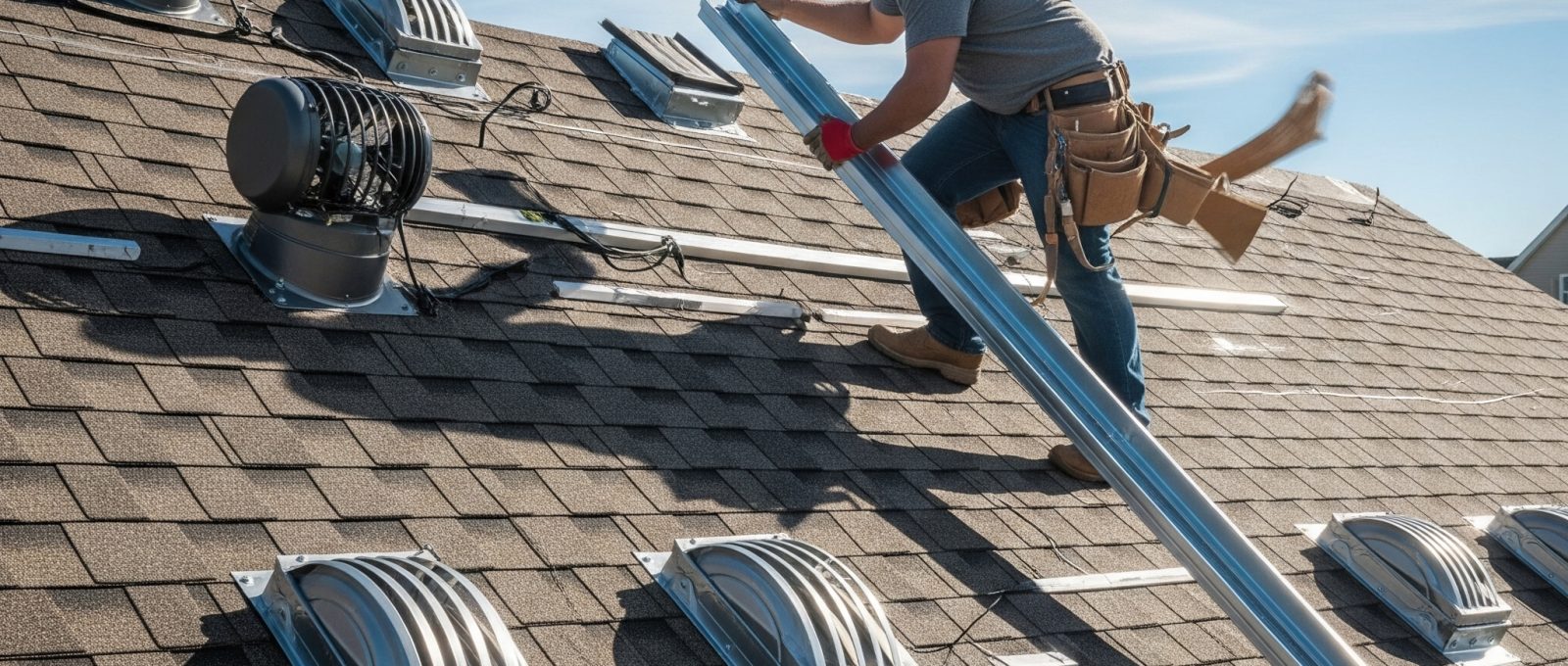Roof ventilation in New Jersey – When homeowners think about roof maintenance, most focus on shingles, gutters, or flashing. But there’s one crucial component that often goes overlooked—roof ventilation. Without proper airflow, even a brand-new roof in perfect condition can deteriorate faster than expected.
At All Pro 1 New Jersey, we’ve inspected and repaired thousands of roofs across the state. One of the most common issues we encounter? Poor attic and roof ventilation. In this post, we’ll explain how ventilation works, why it matters in New Jersey’s climate, and how improving your ventilation can extend your roof’s life, reduce energy bills, and prevent expensive repairs.
📞 Ready for a free ventilation inspection? Call (201) 773-6635 or request your estimate online.
What Is Roof Ventilation—and Why Is It So Important?
Roof ventilation refers to a system of intake and exhaust vents that allow air to circulate through your attic. Proper airflow:
-
Removes hot, moist air from the attic in summer
-
Prevents moisture buildup in winter
-
Keeps your roof deck dry and your insulation functional
-
Reduces heat strain on roofing materials
- Roof ventilation in New Jersey
The goal is to maintain a balanced airflow: cool air enters through intake vents (usually at the soffits), while hot air exits through exhaust vents (such as ridge vents or gable vents).
What Happens When a Roof Isn’t Ventilated Properly?
Without adequate ventilation, your attic becomes a trap for heat and moisture—and that’s where the problems begin.
1. Shortened Shingle Lifespan
Excess heat from the attic can “bake” your shingles from the inside, causing them to:
-
Curl or crack
-
Lose granules
-
Age prematurely
- Roof ventilation in New Jersey
This dramatically reduces the lifespan of your roofing system—even if it was installed perfectly.
2. Mold and Moisture Damage
In colder months, warm air from your home rises into the attic. Without proper exhaust, that warm air condenses on cold roof surfaces, leading to:
-
Mold growth
-
Wood rot in rafters and decking
-
Insulation saturation (which reduces R-value and energy efficiency)
3. Ice Dams
When snow melts unevenly due to attic heat, it refreezes at the roof edges, forming ice dams. These dams trap water, leading to leaks under shingles, water-stained ceilings, and long-term damage.
4. Increased Energy Bills
Improper ventilation forces your HVAC system to work harder to regulate indoor temperatures, especially in the summer when attic temps can exceed 140°F. This can significantly raise your cooling costs.Roof ventilation in New Jersey
Why This Matters More in New Jersey
New Jersey’s climate brings both extremes: humid summers and frigid winters. These conditions make proper roof ventilation essential:
-
Summer heat without airflow causes attic temps to soar
-
Winter condensation encourages mold and ice dam formation
-
Spring and fall bring storm-related moisture that can linger
This four-season climate accelerates wear and tear if your attic doesn’t breathe properly.
Signs Your Roof Ventilation May Be Failing
How can you tell if your roof has ventilation problems? Look for these red flags:
-
Hot second floors or attics in the summer
-
Frost or moisture on attic rafters in the winter
-
Moldy or musty smells in the attic
-
Peeling paint on roof eaves or exterior walls
-
Higher-than-normal energy bills
-
Shingles curling or cracking prematurely
If you notice any of these symptoms, it’s time for a professional inspection.
Best Practices for Roof Ventilation
Every home is different, but effective roof ventilation systems typically include:
Intake Vents
-
Located at the soffits or eaves
-
Let cool air into the attic
-
Must remain unclogged and unobstructed
Exhaust Vents
-
Ridge vents: run along the peak of the roof
-
Box vents: fixed vents near the top of the roof slope
-
Gable vents: found on gable-end walls
-
Powered attic fans: electric or solar fans to push hot air out
- Roof ventilation in New Jersey
The system works best when intake and exhaust are balanced, allowing a steady flow of air through the attic space.
How All Pro 1 New Jersey Can Help
At All Pro 1, we’re more than just roofing contractors—we’re ventilation experts. Here’s how we help homeowners across New Jersey:
-
Free inspections focused on attic ventilation and roof performance
-
Installation of ridge vents, soffit vents, attic fans, and insulation upgrades
-
Full roofing system assessments to ensure long-term durability
-
Guidance on meeting or exceeding manufacturer ventilation requirements (which protect warranties)
If your home was built more than 15 years ago or you’re unsure about your roof’s ventilation, let us take a look—no cost, no obligation.
📞 Call (201) 773-6635 or schedule online.
When to Check Roof Ventilation
We recommend a ventilation inspection:
-
Before replacing your roof
-
After a major storm
-
If you notice ice dams or attic moisture
-
When remodeling or upgrading insulation
-
At least once every 2–3 years, even without symptoms
Don’t Let Poor Ventilation Shorten Your Roof’s Life
Your roofing materials might be top-of-the-line, but without the right ventilation system, they’ll wear out long before they should. Ignoring airflow issues means you risk:
-
Voiding your roofing warranty
-
Higher energy bills
-
Hidden water damage
-
The need for premature roof replacement
Final Thoughts
Proper roof ventilation isn’t optional—it’s essential. It protects your roofing investment, prevents hidden damage, and ensures your home stays energy-efficient and comfortable in every season.
If you’re not sure how well your roof is ventilated, don’t wait until problems show up. Let the experts at All Pro 1 New Jersey take a look.
📞 Call (201) 773-6635 or click here to schedule your free estimate. Breathe easier—your roof will thank you.

